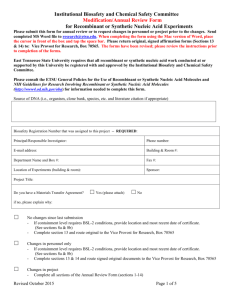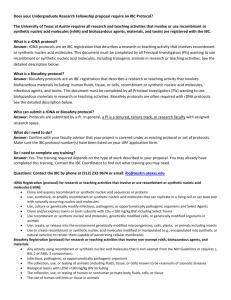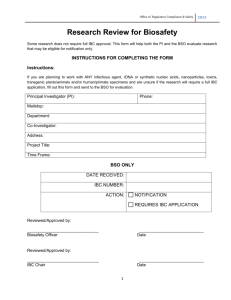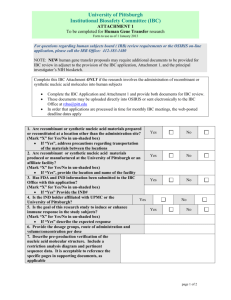The USP Institutional Biosafety Committee (IBC) has been
advertisement
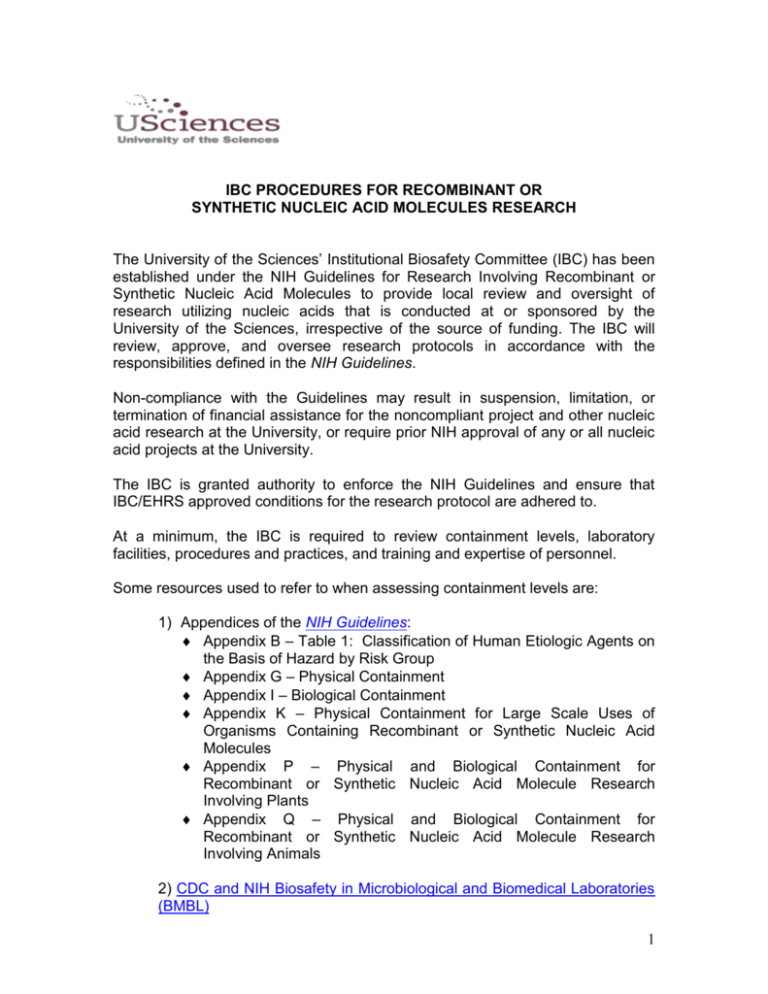
IBC PROCEDURES FOR RECOMBINANT OR SYNTHETIC NUCLEIC ACID MOLECULES RESEARCH The University of the Sciences’ Institutional Biosafety Committee (IBC) has been established under the NIH Guidelines for Research Involving Recombinant or Synthetic Nucleic Acid Molecules to provide local review and oversight of research utilizing nucleic acids that is conducted at or sponsored by the University of the Sciences, irrespective of the source of funding. The IBC will review, approve, and oversee research protocols in accordance with the responsibilities defined in the NIH Guidelines. Non-compliance with the Guidelines may result in suspension, limitation, or termination of financial assistance for the noncompliant project and other nucleic acid research at the University, or require prior NIH approval of any or all nucleic acid projects at the University. The IBC is granted authority to enforce the NIH Guidelines and ensure that IBC/EHRS approved conditions for the research protocol are adhered to. At a minimum, the IBC is required to review containment levels, laboratory facilities, procedures and practices, and training and expertise of personnel. Some resources used to refer to when assessing containment levels are: 1) Appendices of the NIH Guidelines: Appendix B – Table 1: Classification of Human Etiologic Agents on the Basis of Hazard by Risk Group Appendix G – Physical Containment Appendix I – Biological Containment Appendix K – Physical Containment for Large Scale Uses of Organisms Containing Recombinant or Synthetic Nucleic Acid Molecules Appendix P – Physical and Biological Containment for Recombinant or Synthetic Nucleic Acid Molecule Research Involving Plants Appendix Q – Physical and Biological Containment for Recombinant or Synthetic Nucleic Acid Molecule Research Involving Animals 2) CDC and NIH Biosafety in Microbiological and Biomedical Laboratories (BMBL) 1 3) American Biological Safety Association’s Risk Group Classification for Infectious Agents 4) Biological Risk Assessment – Biological Safety Manual 5) Pathogen Safety Data Sheets (PSDS) and Risk Assessment Submission and Review If research will involve the use of recombinant or synthetic nucleic acids, Principal Investigators must complete the Research Protocol Form which includes the Recombinant or Synthetic Nucleic Acid Molecules Registration Document. The completed Research Protocol Form/Registration Document along with a copy of the Scientific Sections from the Research Grant/Contract Proposal should be submitted electronically through the submission program, IRBNet at www.irbnet.org. Protocols should be submitted 3 weeks prior to the upcoming IBC meeting. (Schedule of IBC meetings) It is strongly recommended that the Principal Investigator attend the meeting to answer any questions or address concerns of the IBC, during the review process. If the IBC requests additional information or modifications in order to approve the protocol, the IBC Chair or Administrator will summarize these requests and notify the Principal Investigator. Final approval will be communicated via an approval letter. Nucleic acids research that is exempt from the Guidelines, as described in Section III – F of the Guidelines, must still be forwarded electronically through IRBNet for review for verification and review of other Federal and State standards of biosafety that still apply. See additional information under “Exempt” Recombinant or Synthetic Nucleic Acid Experiments. Each registration is approved for a period of five (5) years from the approval month. After the five year expiration date, the Principal Investigator is required to submit a new Research Protocol Form/Registration Document. An automated email alert will be forwarded 60 days prior as a reminder. Forms are available on IRBNet at www.irbnet.org in the Document Library or in Forms and Templates. Modifications to “Approved” Recombinant or Synthetic Nucleic Acid Experiments The Principal Investigator is responsible for notifying the IBC of any major changes in approved experiments before initiation. The Principal Investigator shall submit the Recombinant or Synthetic Nucleic Acid Research Amendment 2 Form or a new Research Protocol Form/Registration Document for IBC or Chair/Administrator review before implementation of any of the following: A change in host, vector or agent/organism. (Amendment Form) A change in the donor species or nature of the DNA segment selected. (Amendment Form) A change in the location of work/experiments. (Amendment Form) A change of the Principal Investigator or laboratory personnel. (Amendment Form) A change in the biosafety level (BSL). (New Registration Document) A change in the experimental procedures. (New Registration Document) A change in the NIH Experiment Category. (New Registration Document) A new Research Protocol Form/Registration Document needs to be completed if there has been a change that alters the experimental procedures, NIH Experiment Category, the Biosafety Risk Assessment, and/or if more in-depth information is required by the reviewer(s). The IBC must be notified of modifications under Section III-E, Experiments that require Institutional Biosafety Committee Notice Simultaneous With Initiation, at the time they are implemented. “Exempt” Recombinant or Synthetic Nucleic Acid Experiments The Research Protocol Form/Registration Document will be initially reviewed by the IBC Chair/Biosafety Officer and/or a nucleic acid expert on the committee to determine if it falls under the following 8 categories of exemption as described in the NIH Guidelines, Section III – F (Allowable exemptions). Those synthetic nucleic acids that: (1) can neither replicate nor generate nucleic acids that can replicate in any living cell (e.g., oligonucleotides or other synthetic nucleic acids that do not contain an origin of replication or contain elements known to interact with either DNA or RNA polymerase), and (2) are not designed to integrate into DNA, and (3) do not produce a toxin that is lethal for vertebrates at an LD50 of less than 100 nanograms per kilogram body weight. If a synthetic nucleic acid is deliberately transferred into one or more human research participants and meets the criteria of Section III-C, it is not exempt under this Section. Those that are not in organisms, cells, or viruses and that have not been modified or manipulated (e.g., encapsulated into synthetic or natural vehicles) to render them capable of penetrating cellular membranes. Those that consist solely of the exact recombinant or synthetic nucleic acid sequence from a single source that exists contemporaneously in nature. Those that consist entirely of nucleic acids from a prokaryotic host, including its indigenous plasmids or viruses when propagated only in that 3 host (or a closely related strain of the same species), or when transferred to another host by well-established physiological means. Those that consist entirely of nucleic acids from a eukaryotic host including its chloroplasts, mitochondria, or plasmids (but excluding viruses) when propagated only in that host (or a closely related strain of the same species). Those that consist entirely of DNA segments from different species that exchange DNA by known physiological processes, though one or more of the segments may be a synthetic equivalent. A list of such exchangers will be prepared and periodically revised by the NIH Director with advice of the RAC after appropriate notice and opportunity for public comment (see Section IV-C-1-b-(1)-(c), Major Actions). See Appendices A-I through A-VI, Exemptions under Section III-F-6--Sublists of Natural Exchangers, for a list of natural exchangers that are exempt from the NIH Guidelines. Those genomic DNA molecules that have acquired a transposable element, provided the transposable element does not contain any recombinant and/or synthetic DNA. Those that do not present a significant risk to health or the environment (see Section IV-C-1-b-(1)-(c), Major Actions), as determined by the NIH Director, with the advice of the RAC, and following appropriate notice and opportunity for public comment. See Appendix C, Exemptions under Section III-F-8 for other classes of experiments which are exempt from the NIH Guidelines. The Principal Investigator will receive notification in writing from the IBC if the experiment is determined to be exempt. No further action is required by the Principal Investigator unless there is a change in procedures or the use of the nucleic acids that would affect the IBC’s initial determination. However, other federal and state standards of biosafety still apply to the research and must be followed. Periodic Review of Approved Recombinant or Synthetic Nucleic Acid Experiments In accordance with the NIH Guidelines, Section IV-B-2, the IBC will periodically review approved nucleic acid research to ensure compliance with the NIH Guidelines. Periodic reviews will take place on an annual basis. Principal Investigators are responsible for submitting information requested via the Recombinant or Synthetic Nucleic Acid Molecules Research Annual Review Form in a timely manner, meeting the deadlines established by the IBC. An automated e-mail alert will be forwarded 30 days prior as a reminder. Forms are available on IRBNet at www.irbnet.org in the Document Library or in Forms and Templates. 4 Roles and Responsibilities of the Principal Investigator 1. Never initiate or modify recombinant or synthetic nucleic acid research which requires Institutional Biosafety Committee approval prior to initiation until that research or the proposed modification has been approved by the Institutional Biosafety Committee and has met all other requirements of the NIH Guidelines. 2. Determine whether experiments are covered by Section III-E of the NIH Guidelines, Experiments that Require Institutional Biosafety Committee Notice Simultaneous with Initiation, and ensure that appropriate procedures are followed. 3. Report any significant problems pertaining to the operation and implementation of containment practices and procedures, violations of the NIH Guidelines, or any significant research-related accidents and illnesses to the Department of Environmental Health and Radiation Safety. (This includes needlesticks, animal bites, splashes, overexposures, even when not exposed to an infectious substance.) 4. Be adequately trained in good microbiological techniques. 5. Adhere to Institutional Biosafety Committee approved emergency plans for handling accidental spills and personnel contamination. (View the EHRS Biosafety Manual’s Emergency Response Information) 6. Comply with permit and shipping requirements for recombinant or synthetic nucleic acid molecules. (See Appendix H of the Guidelines, Shipment, for shipping requirements and the EHRS Procedures for Shipping Biological Materials) Submissions by the Principal Investigator to the Institutional Biosafety Committee The Principal Investigator will: a) Determine whether the research is subject to Section III-A, III-B, III-C, IIID, or III-E of the NIH Guidelines. b) Determine if your research is exempt from the NIH Guidelines as described in Section III-F. c) Make an initial determination of the required levels of physical and biological containment in accordance with the NIH Guidelines. The Principal Investigator must conduct a risk assessment to determine the proper work practices and containment requirements. Begin by assessing the risk of the agent itself (Risk Group-RG). View Biological Risk 5 Assessments for important subsequent steps needed to be taken for an appropriate assessment. d) Select appropriate microbiological practices and laboratory techniques to be used for the research. e) Submit the initial Research Protocol Form/Registration Document and a copy of the Scientific Sections from the Research Grant/Contract Proposal, and any subsequent changes (e.g., changes in the source of nucleic acid or host-vector system) for Experiments Covered by the NIH Guidelines (III-A, III-B, III-C, III-D, or III-E) to the Institutional Biosafety Committee for review and approval or disapproval. f) Obtain IBC approval before initiating research subject to the NIH Guidelines. (III-A, III-B, III-C, or III-D) g) Research work covered under Section III-E of the NIH Guidelines may commence prior to IBC approval. h) Remain in communication with the Institutional Biosafety Committee throughout the conduct of the project. Responsibilities of the Principal Investigator Prior to Initiating Research The Principal Investigator will: a) Make available to all laboratory staff the protocols that describe the potential biohazards and the precautions to be taken. b) Instruct and train laboratory staff in: (i) the practices and techniques required to ensure safety, and (ii) the procedures for dealing with accidents. This training must be documented and updated periodically and whenever new hazards are introduced. c) Inform the laboratory staff of the reasons and provisions for any precautionary medical practices advised or requested (e.g., vaccinations or serum collection). Responsibilities of the Principal Investigator During the Conduct of the Research The Principal Investigator will: a) Supervise the safety performance of the laboratory staff to ensure that the required safety practices and techniques are employed. (Also, include the proper selection, training and use of personal protective equipment). Document this assessment and training of personal protective equipment 6 (PPE) on the PPE Hazard Assessment Form. b) Investigate and report any significant problems pertaining to the operation and implementation of containment practices and procedures in writing to the Institutional Biosafety Committee or EHRS. c) Correct work errors and conditions that may result in the release of nucleic acid or biohazardous materials. d) Ensure the integrity of the physical containment (e.g., biological safety cabinets) and the biological containment (e.g., host-vector systems that preclude survival of the agent outside the laboratory). Principal Investigators and laboratory staff working with nucleic acids must complete appropriate EHRS trainings prior to working in a laboratory and/or with hazardous materials, and refresher trainings, as required. At a minimum, these trainings include: Laboratory Safety Biosafety Bloodborne Pathogens Incident Reporting Research staff must report any significant problems, violations of the NIH Guidelines, or research-related accidents and illnesses to the Department of Environmental Health and Radiation Safety immediately. Subsequently, the Environmental Health and Radiation Safety Department may be required to report these incidents immediately or within 30 days to the NIH Office of Biotechnology Activities depending on the materials involved and the nature of the incident. The Environmental Health and Radiation Safety Department, in consultation with the Institutional Official, will determine if the incident warrants reporting to NIH Office of Biotechnology Activities. The kind of events that may need to be reported include needlestick or sharps injuries, spills, splashes, overexposures, breaches of containment, animal bites, the escape or improper disposition of a transgenic animal, and failure to adhere to the containment and biosafety practices articulated in the NIH Guidelines. Spills or accidents resulting in an exposure or potential exposure must be reported to the Department of Environmental Health and Radiation Safety even if the nucleic acid or biohazardous material is non-infectious. However, minor spills of low-risk agents not involving a breach of containment that were properly cleaned and decontaminated generally do not need to be reported to NIH. These must still be reported to EHRS. Please complete a Laboratory Incident Report for all laboratory incidents. 7 Laboratory Biosafety Certification Laboratories conducting recombinant or synthetic nucleic acid or biological research are classified as Biosafety Level 1, 2, 3, or 4 based on the guidelines in CDC’s Biosafety in Microbiological and Biomedical Laboratories, 5th edition. All experiments requiring Biosafety Level 2 containment (or higher) will require certification of the laboratory to ensure appropriate safety practices, equipment, and facility design. Therefore, the Principal Investigator should notify the Environmental Health and Radiation Safety (EHRS) Department at X8925 or r.siegel@usp.edu as soon as possible once the laboratory is set up properly for the appropriate containment level. The laboratory certification process may occur simultaneously with the IBC protocol review process, but research cannot begin or hazardous materials cannot be used until the EHRS’s laboratory certification is complete. Currently, there are no research projects at the University of the Sciences classified above Biosafety Levels 1, 2 or 2+ (enhanced). Biosafety Level 3 and Biosafety Level 4 apply to work with exotic agents of increasingly greater potential for causing serious human illness or death. Laboratory facilities that would meet the requirements of these biosafety levels are not available at the University of the Sciences. A copy of the EHRS Biological Safety Manual is available at http://www.usip.edu/safety/bimanual/index.htm Please ensure that everyone in the laboratory is aware of the location and has read through the manual. Recombinant and Synthetic Nucleic Acid Molecules are defined by NIH as: i. ii. iii. Molecules that a) are constructed by joining nucleic acid molecules and b) can replicate in a living cell (i.e., recombinant nucleic acids); Nucleic acid molecules that are chemically or by other means synthesized or amplified, including those that are chemically or otherwise modified but can base pair with naturally occurring nucleic acid molecules (i.e., synthetic nucleic acids); or Molecules that result from the replication of those described in (i) or (ii) above. 8

